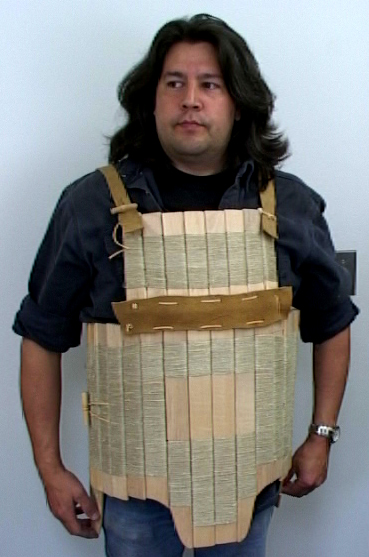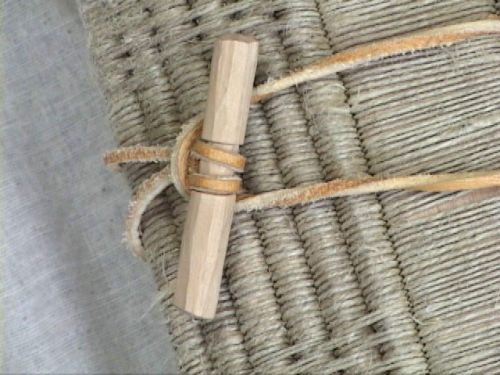The Tlingit artist Tommy Joseph has replicated a traditional set of armour:
… body armor made of alder slats and rods and woven together with hemp. Wooden panels are stitched together with leather lacing. Moosehide straps. Two alder toggles fasten the armor around the body.
It’s for sale: $3,500.
I was looking into this because of a recent post on Linen Armour (!) at Heather Pringle’s blog — I tried to leave a comment there in response to a question about NW Coast armour but wordpress ate it — probably because I had a bunch of links. Dan form there, if you read this, most likely the armour Simon Fraser saw was made of two or more layers of stiffened elk hide.




Thanks so much for posting this. This Northwest Coast style of body armor is incredibly ingenious and very sturdy looking.
LikeLike
Thanks kindly, Heather linked to your blog, and I didn’t stop by for another look until today!
I have other questions relating to Simon Fraser’s journal.
He saw an iron pot – I think it was somewhere between Chillwack and Lillooet (don’t have the journal handy).
Where would it have come from?
(My guess is Russian traders)
LikeLike
Hi Dan,
Thanks for stopping by.
I am no expert on the early historic period! Based on what you say, though, I would not point towards the Russians but to the various ships engaged in the maritime fur trade (the sea otter pelt trade). Captain Vancouver came into the Straits of Georgia in 1792, but even by that time there was widespread presence of fur traders on the west coast of Vancouver Island and on the north Coast. Many of the traders were American (“Boston Men”) and most of the the rest, British. Iron was one of the main trade items, especially iron chisels and iron pots. So, by 1808, I think it entirely likely that Fraser River aboriginal groups had ready access through trade to European trade goods and the likely source was down-the-line trade (aboriginal group to group to group) from those most directly implicated in the fur trade itself.
Again, this would be my best guess but I am certain such useful items as iron kettles were a popular trading item by 1808, that hundreds or even thousands had been brought to the coast even by that early a date, and that First Nations would trade them to their neighbours at considerable profit.
All the best
qmackie
LikeLike
Interesting post, and interesting to see you used the images from our website. But yes, Tlingit armor is indeed impressive and functional. ZJ
LikeLike
Here’s a interesting drawing of Nuu-chah-nulth armour collected in 1786.

http://www.britishmuseum.org/research/collection_online/collection_object_details.aspx?objectId=3271561&partId=1
The caption reads:
The front part of a Coat of Armour brought back from Nootka Sound on the NW Coast of America. Brought back by James Strange Esq. 1786 now in the collection of J.McGowan of Edinburgh. Height 20 inches gorget included. Breadth 19 inches & 1/2. Thickness 1/4 of an inch bare. Height on the highest part of the Gorget 5 1/4 inches.
LikeLiked by 1 person
Here’s another interesting set of almost 4,000 year old bone armour from western Siberia
http://siberiantimes.com/science/casestudy/features/warriors-3900-year-old-suit-of-bone-armour-unearthed-in-omsk/
LikeLike
hi
how much did this weigh
and do you have any sources to the tlingit ( or native culture in general)
i heard vikings refered to as ‘the ones who wore wooden armour’
and now its getting heated in the chat
LikeLike
why Alder there are alot of tougher local wood to use?
LikeLike